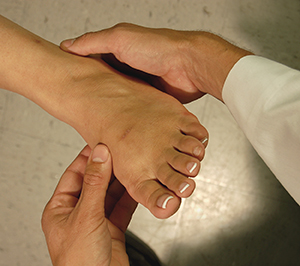Diabetes: Keeping Feet Healthy
Diabetes is a chronic (long-term) condition characterized by elevated blood sugar levels. It can damage nerves in your feet (neuropathy), resulting in weakness, numbness, and pain. The nerve damage may make it hard to feel injuries or sore spots. Diabetes can also change blood flow. This can make it harder for small problems, like a blister, to heal. In fact, small injuries can quickly become serious infections. They can send you to the hospital. Self-care is key. It helps protect your feet and keep them healthy.
Take special care
These tips can help you care for your feet:
-
Check your feet daily for problems such as swelling, redness, and blisters. Also look for cracks, dry skin, changes in skin color, or numbness. Use a mirror to see the bottoms of your feet. Or ask for help. Try to check your feet at the same time each day.
-
Manage your diabetes. Check and control your blood sugar. Take all your medicines as prescribed and follow a healthy lifestyle. Call your healthcare provider if you have trouble controlling your blood sugar.
-
Don't walk barefoot, even indoors. Always wear socks inside your shoes. Make sure you change your socks every day and wear only clean, dry socks.
-
Wash your feet with warm water and mild soap. Check the water temperature before putting your foot in the water. Dry feet well, especially between your toes.
-
Don’t treat ingrown toenails, corns, or calluses yourself. Talk with your provider or foot healthcare specialist (podiatrist) if you need help trimming your toenails. Ask your podiatrist for a foot care plan.
-
Use skin cream or lotion if you have dry skin. But don’t use it between your toes.
-
Don’t use heating pads on your feet. If you have nerve damage (neuropathy), you could get a burn and not feel it.
-
Stop smoking. Smoking limits blood flow. It can make it harder for wounds to heal.
-
Limit alcohol consumption. Alcohol can affect blood sugar control and contribute to nerve damage.
-
Don't use sharp blades to trim your nails. Use a nail clipper and file instead.
Have regular checkups
Foot problems can happen fast. Follow your healthcare team’s schedule for checkups. During office visits, take off your shoes and socks as soon as you get in the exam room. Ask your provider to check your feet for problems. This will make it easier to find and treat small skin problems before they get worse. Regular checkups can also help keep track of the blood flow and feeling in your feet. In some cases, you may have a decrease in the pulses in your feet. Then your provider may refer you to have special measurements taken of the blood pressure in your arms and legs. You may need to have checkups more often if you have neuropathy.
 |
| Have your feet checked every time you see your healthcare provider, and at least once a year. |
Wear the right footwear
Wearing correct footwear is very important. Too much pressure can damage parts of your feet. Then your provider may advise changing your footwear. You may need to not wear high heels or tight work boots. Or your provider may advise special shoes or inserts. These help protect your feet. And they keep current problems from getting worse. If you need special footwear, ask your provider if you qualify for Medicare's custom-molded and extra-depth diabetic shoe and insert program.
Make sure shoes and socks fit
Any pair of shoes—new or old—should feel comfortable as soon as you put them on. There shouldn’t be any rubbing or pinching when you walk. Wear the right shoes for the activity you are doing. For instance, a running shoe is meant to keep your feet free from injury while you jog. Buy shoes at the end of the day, when your feet are larger. Check that they provide support without feeling too loose. Check that your socks fit, too. Wear soft, seamless, well-padded socks for activity. Cotton or microfiber socks are best. They help to absorb sweat. To protect your feet, don't wear open-toed or open-heeled shoes. Talk with your healthcare team if you have questions about what kinds of shoes and socks are best for you.
.
Get regular exercise
Regular exercise helps blood flow in your feet. It also helps make your feet stronger and more flexible. Gentle exercises such as walking or riding a stationary bike are best. You can also do special foot exercises. Talk with your provider before starting any exercise program. Also tell your provider if any exercise causes pain, redness, or other foot problems.
Note: If you have any kind of break in the skin of your foot or ankle, keep the area clean. Then call your healthcare provider. This is especially true if the area doesn’t seem to be healing.
Online Medical Reviewer:
Chris Southard RN
Online Medical Reviewer:
Heather M Trevino BSN RNC
Online Medical Reviewer:
Rajadurai Samnishanth Researcher
Date Last Reviewed:
4/1/2024
© 2000-2025 The StayWell Company, LLC. All rights reserved. This information is not intended as a substitute for professional medical care. Always follow your healthcare professional's instructions.